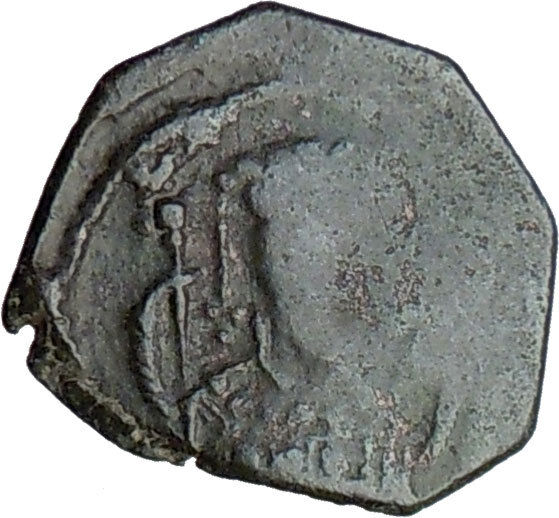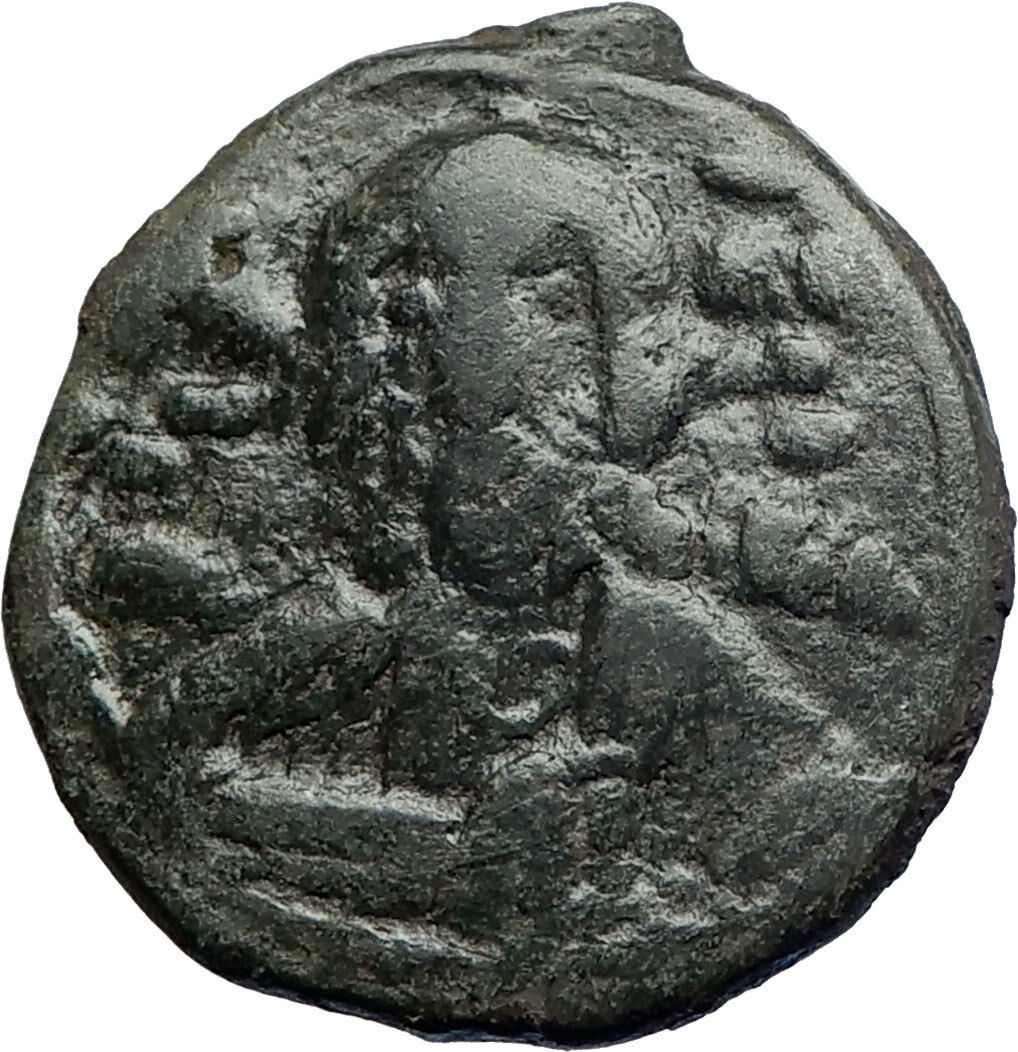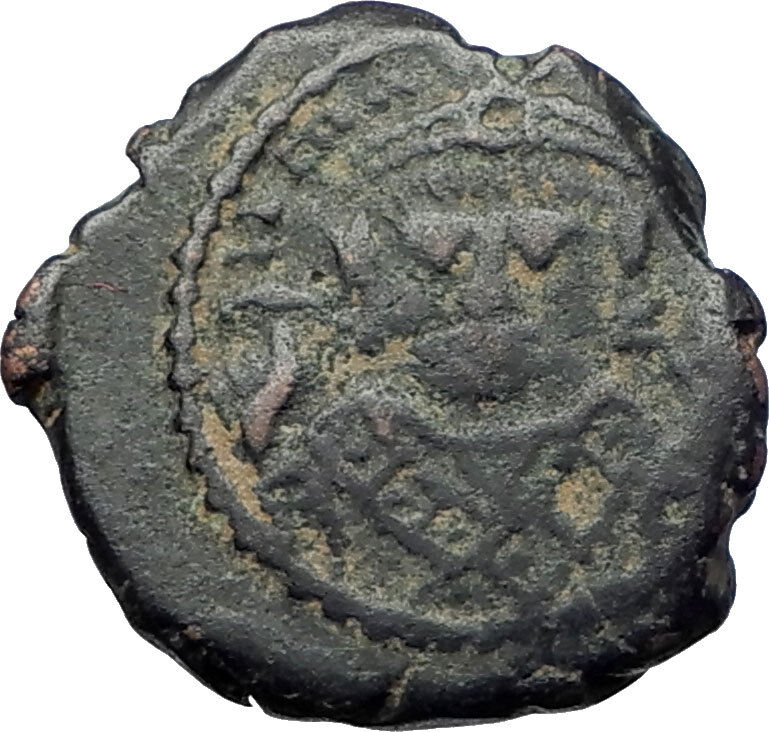|
Andronicus II , Palaeologus – Byzantine Emperor: 11
December 1282 – 24 May 1328 A.D.
Michael IX – Byzantine Co-Emperor: Many 21, 1295-October 12, 1320 A.D.
Bronze Assarion 20mm (1.24 grams) Constantinople mint 1294-1320 A.D.
Reference: DOC 689; SB 2440.
Half-length facing busts of Andronicus and Michael, holding labarum between
them
Legend in four lines.
You are bidding on the exact
item pictured, provided with a Certificate of Authenticity and Lifetime
Guarantee of Authenticity.
The Chi Rho is one of the earliest
christograms
used by Christians. It is formed
by superimposing the first two letters in the Greek spelling of the word
Christ
(
Greek
: “Χριστός” ), chi = ch and rho = r, in
such a way to produce the
monogram
☧. The Chi-Rho symbol was
also used by pagan Greek scribes to mark, in the margin, a particularly valuable
or
relevant passage; the combined letters Chi and Rho standing for chrēston,
meaning “good.” Although not technically a cross, the Chi Rho invokes the
crucifixion of Jesus as well as symbolizing his status as the Christ. There is
early evidence of the Chi Rho symbol on Christian Rings of the third century.
The labarum (Greek:
λάβαρον) was a
vexillum
(military standard) that displayed
the “Chi-Rho”
symbol, formed from the first two
Greek letters
of the word “Christ”
(Greek:
ΧΡΙΣΤΟΣ, or Χριστός) — Chi (χ)
and Rho (ρ).
It was first used by the
Roman emperor
Constantine I
. Since the vexillum consisted of
a flag suspended from the crossbar of a cross, it was ideally suited to
symbolize crucifixion
. The Chi-Rho symbol was also used
by Greek scribes to mark, in the margin, a particularly valuable or relevant
passage; the combined letters Chi and Rho standing for chrēston, meaning
“good.”
Michael IX Palaiologos or Palaeologus (Greek:
Μιχαήλ Θ΄ Παλαιολόγος, Mikhaēl IX
Palaiologos), (April 17, 1277 – October 12, 1320,
Thessalonica
,
Greece
), reigned as Byzantine co-emperor with
full imperial style 1294/1295–1320. Michael IX was the eldest son of
Andronikos II Palaiologos
and
Anna of Hungary
, a daughter of King
Stephen V of Hungary
.
Life
Michael IX Palaiologos was acclaimed co-emperor in 1281 and was crowned in
1294 or 1295. In 1300, he was sent at the head of Alanian mercenaries against
the Turks in
Asia Minor
, and in 1304–1305 he was charged
with dealing with the rebellious
Catalan Company
. After the murder of the
Catalan commander
Roger de Flor
, Michael IX led the Byzantine
troops (augmented by Turks and 5–8,000 Alanians) against the Catalans, but was
defeated and wounded.
Michael IX was also ultimately unsuccessful against
Theodore Svetoslav of Bulgaria
in 1307,
concluding peace in 1307 and marrying his daughter to the Bulgarian emperor. In
1311, Michael IX was defeated by Osman I. Michael IX eventually retired to
Thessalonica
, where he died in 1320.
A brave and energetic soldier willing to make personal sacrifices to pay or
encourage his troops, Michael IX was generally unable to overcome his enemies
and is the only Palaiologan emperor to predecease his father. Michael IX’s
premature death at age 43 was attributed in part to grief over the accidental
murder of his younger son Manuel Palaiologos by retainers of his older son and
co-emperor
Andronikos III Palaiologos
.
Family
Michael IX Palaiologos married
Rita of Armenia
(renamed Maria, later nun Xene),
daughter of King
Leo III of Armenia
and
Queen Keran of Armenia
on 16 January 1294. By
this marriage, Michael IX had several children, including:
-
Andronikos III Palaiologos
- Manuel Palaiologos, despotēs
- Anna Palaiologina, who married
Thomas I Komnenos Doukas
and then
Nicholas Orsini
.
- Theodora Palaiologina, who married
Theodore Svetoslav of Bulgaria
and then
Michael Asen III of Bulgaria
.
Andronikos II Palaiologos (Greek:
Ανδρόνικος Β’ Παλαιολόγος) (25
March 1259
,
Nicaea
–
February
13
, 1332
,
Constantinople
) — also Andronicus II Palaeologus — reigned as
Byzantine emperor
from 1282 to 1328. He was the eldest surviving son of
Michael VIII Palaiologos
and
Theodora Doukaina Vatatzina
, grandniece of
John III Doukas Vatatzes
.
//
Andronikos II Palaiologos was acclaimed co-emperor in 1261, after
his father Michael VIII recovered
Constantinople
from the
Latin
Empire
, but he was crowned only in 1272. Sole emperor from 1282, Andronikos
II immediately repudiated his father’s unpopular Church union with the
Papacy
(which he had been forced to support while his father was still
alive), but was unable to resolve the related schism within the Orthodox clergy
until 1310. Andronikos II was also plagued by economic difficulties and during
his reign the value of the Byzantine
hyperpyron
depreciated precipitously while the state treasury accumulated less than one
seventh the revenue (in nominal coins) that it had done previously. Seeking to
increase revenue and reduce expenses, Andronikos II raised taxes and reduced tax
exemptions, and dismantled the Byzantine fleet (80 ships) in 1285, thereby
making the Empire increasingly dependent on the rival republics of
Venice
and
Genoa
. In 1291, he hired 50-60 Genoese ships. Later, in 1320, he tried to
resurrect the navy by constructing 20 galleys, but unfortunately he failed.
Andronikos II Palaiologos sought to resolve some of the problems facing the
Byzantine Empire
through diplomacy. After the death of his first wife, he
married
Yolanda (renamed Eirene) of Montferrat
, putting an end to the Montferrat
claim to the
Kingdom of Thessalonica
. Andronikos II also attempted to marry off his son
and co-emperor
Michael IX Palaiologos
to the Latin Empress
Catherine I of Courtenay
, thus seeking to eliminate Western agitation for a
restoration of the
Latin
Empire
. Another marriage alliance attempted to resolve the potential
conflict with Serbia
in
Macedonia
, as Andronikos II married off his five-year old daughter
Simonis
to
King
Stefan Milutin
in 1298.
In spite of the resolution of problems in
Europe
,
Andronikos II was faced with the collapse of the Byzantine frontier in
Asia Minor
. After the failure of the co-emperor Michael IX to stem the
Turkish advance in Asia Minor in 1300, the Byzantine government hired the
Catalan Company
of
Almogavars
(adventurers from Aragon
and
Catalonia
)
led by
Roger
de Flor
to clear Byzantine Asia Minor of the enemy. In spite of some
successes, the Catalans were unable to secure lasting gains. They quarreled with
Michael IX, and eventually turned on their Byzantine employers after the murder
of Roger de Flor in 1305, devastating
Thrace
,
Macedonia, and Thessaly
on their road to Latin Greece. There they conquered the
Duchy of Athens
and
Thebes
. The Turks continued to penetrate the Byzantine possessions, and
Prusa
fell in 1326. By the end of Andronikos II’s reign, much of Bithynia
was in the hands of the
Ottoman Turks
of Osman I and his son and heir
Orhan
. Also,
Karesi
conquered Mysia
region with Paleokastron
after 1296, Germiyan conquered
Simav
in 1328,
Saruhan captured Magnesia
in 1313 and
Aydınoğlu
captured Symirna
in 1310.
The Empire’s problems were exploited by
Theodore Svetoslav of Bulgaria
, who defeated Michael IX and conquered much
of northeastern Thrace in c. 1305-1307. The conflict ended with yet another
dynastic marriage, between Michael IX’s daughter Theodora and the Bulgarian
emperor. The dissolute behavior of Michael IX’s son
Andronikos III Palaiologos
led to a rift in the family, and after Michael
IX’s death in 1320, Andronikos II disowned his grandson, prompting a
civil war
that raged, with interruptions, until 1328. The conflict
precipitated Bulgarian involvement, and
Michael Asen III of Bulgaria
attempted to capture Andronikos II under the
guise of sending him military support. In 1328 Andronikos III entered
Constantinople in triumph and Andronikos II was forced to abdicate. He died as a
monk in 1332.
|







